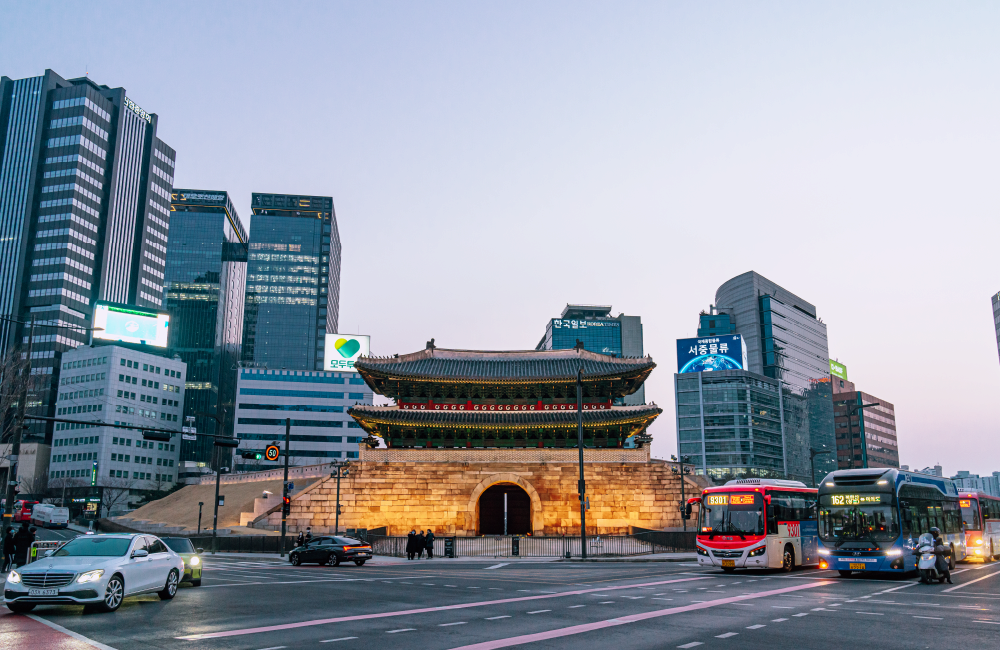The area inside the “Four Great Gates” (Sadaemun-an) of Seoul refers today to the districts of Jongno-gu and Jung-gu, with Gwanghwamun as its center. This area has been the heart of the capital since the Joseon Dynasty. Known in the past as “Hanyang,” it was the core of politics, economy, and culture, and the scene of a vibrant urban life. Palaces, government offices, bustling markets, residences of nobles, and commoners’ neighborhoods all coexisted, creating a space full of stories that eventually became the very roots of modern Seoul. In this article, we’ll briefly look into how people lived inside the Four Great Gates during the Joseon era, and how the capital city was managed at that time.
Structure of the Four Great Gates and the Capital Fortress
The “Four Great Gates” region was established when King Taejo Yi Seong-gye founded Joseon and designated Hanyang as the capital, centering it on the royal palace, Gyeongbokgung. He ordered the construction of four main gates (Heunginjimun, Sukjeongmun, Sungnyemun, and Donuimun) along with four minor gates, surrounded by fortress walls. The purpose of this wall was both defense against invasions and maintaining urban order. People passed through the gates for trade, administration, and daily life, creating a lively hub of activity.
Royal palaces such as Gyeongbokgung, Changdeokgung, Changgyeonggung, Deoksugung, and Gyeonghuigung were distributed inside and around the gates, creating the center of governance. Surrounding these were government offices and residences of the Joseon aristocracy. At the same time, markets and commoners’ neighborhoods were interspersed throughout the city, resulting in a relatively dense population. Over time, the inside of the Four Great Gates developed into a dynamic and noisy metropolis, filled with bull carts, street merchants, government officials’ processions, and the daily echoes of ordinary people’s lives.

Life of Nobles and Commoners
Inside the Four Great Gates, the noble class (yangban) led politics, scholarship, and culture, while commoners, middle-class professionals, and merchants sustained their livelihoods through various occupations. The yangban frequently moved between government offices and the royal palaces to manage state affairs and prepare for civil service examinations. Meanwhile, in the Jongno area, bustling markets and shops created an active commercial district. By the late Joseon Dynasty, peddlers and professional merchants increased, and the so-called “Jongno commercial network” rose to become a major axis of the national economy.
Living spaces also reflected social class distinctions. Nobles displayed their status by owning traditional Korean mansions (hanok) near Jongno or Bukchon (around Changdeokgung), while commoners rented modest houses or small shop buildings in alleyways. However, as the city expanded and markets grew, some upward mobility was possible. At the same time, poorer residents were pushed out to peripheral neighborhoods such as Nakwon-dong or Hyehwa-dong.
Market Culture and Commercial Growth
Within the Four Great Gates, government-licensed stores known as “Yukijeon” thrived. In the Jongno area, numerous textile shops, herbal medicine vendors, and hardware stores lined the streets. The Yukijeon monopolized sales of items such as silk, cotton, seafood, ginseng, medicine, and general goods, contributing to state finances. Meanwhile, independent merchants competed with them and provided diverse products, enriching urban life even further. Old paintings of these marketplaces illustrate the busy mixture of pedestrians, vendors, and street stalls.
From early morning until evening, the movement of goods and people never ceased. In the late Joseon period, with the wider circulation of Sangpyeong Tongbo (a standardized copper coin), commerce flourished more than ever. The Four Great Gates grew into the driving engine of Joseon’s economy, drawing goods from rural areas and provinces—salt, seafood, rice—into large-scale trade. As a result, lifestyles diversified, and leisure spaces such as tea houses, taverns, and eateries appeared, providing entertainment for city dwellers.
Royal Ceremonies and Festivals
Because the royal palaces were nearby, the Four Great Gates often transformed into grand stages for national ceremonies and festivals. Military reviews personally attended by the king, receptions for foreign envoys, and royal wedding processions of crown princes were major spectacles, drawing citizens to the streets. Such events were so influential that they even affected market prices, deeply intertwining official state affairs with ordinary life.
Sacred spaces like Jongmyo Shrine and Sajikdan Altar provided solemn backdrops for state rituals. During these ceremonies, large groups of court musicians and ceremonial guards were mobilized, creating a majestic atmosphere. Common people either observed from afar or sometimes took part, collectively wishing for the prosperity of the royal family and the nation. Thus, the Four Great Gates became both the very heart of monarchical politics and a lived-in space for common people, fostering a uniquely rich urban culture.
Alley Culture and Transport
The alleys inside the Four Great Gates during the Joseon era were far narrower than today. Houses densely filled the narrow winding streets. Carts, horses, and human porters were the main modes of transport. Except for the government roads, pavements were often poor, causing muddy conditions on rainy days. Yet, stalls and small vendors lined alleyways, offering food and goods that supported daily city life, while these spaces also fostered casual interactions among neighbors.
It is also said that Seoul’s capital city plan was aligned with traditional geomancy (pungsu-jiri), framed by the protective mountains of Mt. Namsan in the east (Blue Dragon) and Mt. Inwang in the west (White Tiger). This gave the city a balance of nature and aesthetics. Walking along preserved sections of the Seoul City Wall today offers a glimpse into the ancient notion of urban design and how Joseon people conceptualized their capital.
Link to Modern Seoul
Modern-day Jongno and Jung-gu mix high-rise buildings with historic landmarks. Palaces such as Gyeongbokgung, Changdeokgung, Changgyeonggung, and Jongmyo Shrine remain, testifying to the dynasty’s legacy. Bukchon, Seochon, and Ikseon-dong have transformed hanok houses into cultural hubs, while remnants of old markets and shops still stand on Jongno streets, embodying the coexistence of tradition and modernity in Seoul’s urban aesthetics.
Recently, historical programs like the “Four Great Gates Tour” and “Seoul Fortress Trekking” have become popular with travelers. These routes allow visitors to explore fortress walls, city gates, palaces, Jongmyo Shrine, alleyways, and markets—experiencing Seoul’s story from the Joseon Dynasty to the present. This type of immersive urban exploration often sparks awe, revealing the deep layers of history hidden behind today’s skyscrapers.
Conclusion: Breath of History within the Capital Fortress
Life inside the Four Great Gates during the Joseon Dynasty was a living drama of politics, culture, and economy combined in one place. Major state decisions and ceremonies influenced everyday routines, while marketplaces and alleys bustled with energy provided by ordinary people. Exploring the roots of modern Seoul, one realizes these traces and stories still linger and breathe through the city today.
For travelers, a relaxed stroll through the palaces, traditional streets, museums, and alleys within the Four Great Gates area is highly recommended. Even amidst the neon signs and constant traffic, at locations like Cheonggyecheon Stream or Jongmyo Shrine, you may suddenly catch a glimpse of the Joseon era. Imagining, “Perhaps a royal parade walked here? Perhaps vendors once called out here?” allows past and present to overlap, leaving a heart-stirring impression of Seoul’s living history.


WeBring Service : Provides personalized services to foreigners living in Korea
Exclusive offer: Introducing foreign car rental in Korea, WeBring-SoCar

